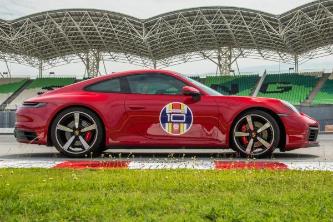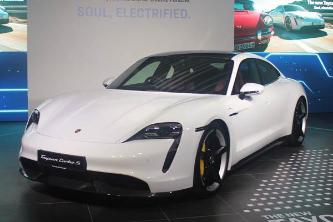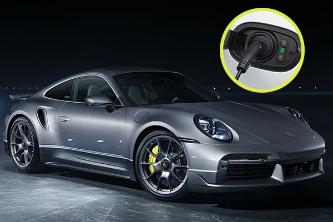porsche taycan obd
Artikel Terkait porsche taycan obd

Will Malaysia be launching a CKD Porsche Macan?
Following a report by The Edge Weekly, it seems that Porsche is seeking to locally-assemble (CKD) some
A CKD Porsche Cayenne will be launched in Malaysia, CKD Taycan next
In what could be a first not just for Malaysia, but also the world, Porsche is reportedly setting up
Nearly half of Porsche Asia Pacific's sales come from EVs and hybrids, Q1 2021 its best ever
Centre Ara DamansaraFirst deliveries of the Porsche Taycan also took place in Q1 2021, with 150 units
Porsche Taycan mixes water with electricity at Sydney's Darling Harbor
Porsche Australia launched the 2021 Porsche Taycan earlier this month.
Review: Porsche Taycan 4S - an electrifying, synapse-frying performance car
" Asked my colleague Shaun as we barrelled along in the Porsche Taycan 4S.
Porsche Taycan debuts: 761 PS and 1,050 Nm, needs only 2-Speed transmission
Apart from minor details, the production Porsche Taycan managed to retain much of the 2015 Frankfurt
Geely KX11 new flagship SUV will get a passenger display screen like a Porsche Taycan!
Although one cannot help to think that this set up resembles the cabin of a Porsche Taycan.See the resemblance
New Porsche Panamera gets 630 PS & 820 Nm, electric Panamera coming soon?
Porsche’s PASM (Porsche Active Suspension Management) and PDCC (Porsche Dynamic Chassis Control
Can Tesla Model 3 Performance do the same as the new Porsche Taycan on 0-90-0?
The all-electric Porsche pulled off a 0-90-0 spec of an impressive 10.17 seconds.
Porsche Taycan launched in Thailand - costs over RM 1.5 million
Porsche Thailand by AAS Auto Service (AAS), the sole authorised importer and distributor of Porsche cars
1 in 8 Porsches sold is a Porsche Taycan, main demand from China
Porsche has delivered 9,072 units of the Porsche Taycan world-wide in the first quarter of 2021, only
Malaysian orders opened for freshly debuted 2021 Porsche Taycan Cross Turismo
For those who think the Porsche Taycan needs extra space in the rear, well, here’s the stunningly
Built on evolved Taycan platform, Audi A6 e-tron concept debuts at 2021 Shanghai Auto Show
sleek side view cameras.The PPE platform is a further development from the J1 platform used for the Porsche
Over 1,000 EVs registered in Thailand in 2020, MG ZS EV more popular than Tesla
xEVs sold in Thailand to be locally-assembled by 2035, Thai gov sets lofty ambitionLuxury EVS like the Porsche
Watch: Ambulance taken advantage by Porsche Taycan
Over the weekend, social media was abuzz as they united to criticise the actions of a pink Porsche Taycan
This Porsche gathering reminds us the joy of driving
Up in the north of Thailand, a yearly gathering of Porsche cars shows us the joy of driving through the
With Shell's DC fast chargers, you can drive a Porsche Taycan from Penang to Singapore
Porsche Asia Pacific and Shell have struck up a new partnership to implement the first cross-border high-performance
From Hot Wheels-inspired hypercars to a modern VW Bus – The gems of Porsche Unseen
Porsche is more than just a maker of an uber fast version of the Volkswagen Beetle, it’s an innovative
Want an electric car? Here are EVs available in Malaysia and her neighbouring countries
Porsche TaycanPorsche Taycan 4S Porsche Taycan Availability Country Starting Price (RWD)
John Wick star Keanu Reeves ditches Mustang for Porsche Taycan, electric drifts ensue
Californian Coast for an electrifying adventure.With only one charge, both actors managed to experience the Taycan
Mobil Terkait Porsche Taycan
Kamu Juga Suka
Review Q&A porsche taycan obd
In what way could engineers make EV charging faster? Is there any electronics solution or does it lie in battery chemistry?
First you should ask if we ,need, faster charging, given that most electric vehicle drivers spend little or no time waiting for vehicle charging. But let’s dig into the topic a bit. Battery Chemistry Lithium-ion cells used in most electric vehicles today have certain safe operating parameters. These vary according to the precise chemistry, but a typical safe maximum voltage is 4.2 V per cell, and a minimum around 3.2 V. Charging rates slow as the state of charge approaches 100%. To protect the battery and extend its life, they are never charged to their fullest capacity possible, or discharged to 0. Overcharging introduces a risk of overheating and cell damage, a complete discharge will damage the cell. The battery management system will monitor each cell’s voltage and stop charging when the highest voltage reaches a predetermined maximum (around 4.2V). The BMS will similarly cut off the power supply if a cell’s voltage falls below the minimum (around 3.2V), at which point the car is not drivable. But all electric vehicles will provide a driver plenty of warning before this happens. Due to the tapered rates at high states of charge, fast charging (level 3 or DCFC) is usually recommended up to 80%. Beyond 80% charging rates can diminish to the point where it is little faster than conventional level 2 charging. I rarely drive my electric vehicles below 10% state of charge, to avoid getting stranded. The fastest charging rates can be sustained up to around 50–60% state of charge. Beyond that it tapers off gradually. No matter which car you drive, charging will be fastest if you use about half the battery’s capacity. For example, if you have a battery with 250 miles of capacity, stopping to charge every 125 miles or so will give you faster charging rates than attempting to stop fewer times and charging to full. The fastest charging rate I have seen in my Bolt EV is 57 kw while using a 125 kw DCFC charging station. This peak is achieved at just over 50% state of charge. The car is also capable of up to 60 kw of regenerative braking, putting energy back into the battery while slowing the car. The process of charging the battery while braking is similar to using a fast charging station, although braking is rarely sustained—heavy braking is normally limited to a few seconds at a time during typical driving. Battery Management System The BMS is responsible for managing the maximum safe rate of charge as well as thermal management of the battery, for vehicles equipped with battery heating or cooling. It also handles cell balancing, and monitors the voltage of each cell for safe thresholds. When the battery is nearly full, the BMS begins cell balancing so that all cells have approximately an equal amount of charge, to maximize the battery pack’s overall capacity. This cell balancing is a slow process, and only practical when charging by level 1 or level 2 (such as overnight). The graph below shows charging rates for my electric vehicle while charging overnight on a level 2 (AC) station: At 1 AM power consumption increased to about 4 kw as battery charging began at its scheduled time. Starting at 4 AM, charging began to taper off until charging was complete shortly below 6 AM. At this point the car has roughly a 95% state of charge. The actual peak power used by the charging station was approximately 3.6 kw (240 VAC at 15 A). Below is a cell-by-cell view of battery voltages after charging. These readings are taken from the BMS and reported by an application plugged into the car’s OBD-II port: This was taken near a full charge while cell balancing is taking place. Average cell voltage is 4.106 V, and the min/max are only 13 mV apart. The other significant purpose of a BMS is to monitor battery temperature and adjust charging accordingly. A cold battery cannot charge (or discharge) rapidly, so the charging rate must be adjusted accordingly. If the car is equipped with thermal battery management (heating and cooling), the BMS will also activate those systems to keep the battery at an optimum operating temperature. Charging Stations A direct-current fast charging (DCFC) station is the fastest way to add energy to an electric vehicle’s battery. A car can charge no faster than the maximum rate of a charging station, but a high-power station can only deliver as much power as the vehicle can accept. Essentially, charging rates are always limited to the maximum of the vehicle’s BMS (which varies according to state of charge and temperature) and the power available from the charging station. There are public stations available today capable of 350 kW charging, but the fastest most electric vehicles can charge now is about 200 kW. At that rate, the car will gain about ten miles of range per minute of charging. Please realize just how much power 200 kW represents. At 400V (typical for an electric vehicle battery) that is 500 amps of continuous DC current. At such high currents, a thick conductor (wire) is needed to carry the current from the charging station to vehicle. These conductors are expensive, and heavy. They need to be light enough so that an average human can easily lift the plug from the station and attach it to their vehicle. Tesla has started using liquid-cooled conductors at its fastest superchargers to keep the cable size down without creating excessive heat while charging. Another possibility is to increase charging power by increasing voltage rather than current. The Porsche Taycan uses an 800V system. This helps to solve the charging problem of needing heavy conductors, but it creates another—800 volts is enough to breach a thin insulator, so heavier/thicker insulation is needed on an 800 VDC charging station, and throughout the high-voltage wiring of the vehicle. Power Supply All but the lowest-power DCFC stations need a 480 V supply from the utility company. This kind of power isn’t available for residential use, and requires a commercial installation and perhaps a dedicated transformer. Homes that have even 200 A service cannot power a 50 kW electric vehicle charging station, let alone a 350 kW station. Such stations can only be located where sufficient power is available from the electric utility provider. In summary, there are many challenges to creating higher-power charging stations than those available today for electric vehicles. The challenges lie in battery cooling, battery design, climate, charging stations, and even power from the electric utility. But the current state of the art is enough for most EV drivers. Most EV drivers will never need DCFC unless taking a long trip—they can just plug in and fully charge their vehicle overnight. Personally, if I need to stop for 20 minutes to recharge after driving 3 hours, it would be a welcome stop—a chance to use the restroom, buy food/drinks, and just stretch my legs. (Unlike a gasoline vehicle, you don’t need to attend the vehicle while charging.)
FAQs Terkait porsche taycan obd
Tell me the Assist System of Porsche Taycan.
The Assist System of the Porsche Taycan are as follow:
Variants 2019 Porsche Taycan Turbo 2019 Porsche Taycan Turbo S Parking Sensor Front Parking Sensor Rear Parking Camera Cruise Control Y Y Auto Parking Auto Start/Stop Hill Start Assist Does Porsche Taycan has Paddle Shift?
No, Porsche Taycan doesn't have Paddle Shift.
Is Porsche Taycan available in Engine Start?
No, Porsche Taycan isn't available in Engine Start.
 Beranda
Beranda 



